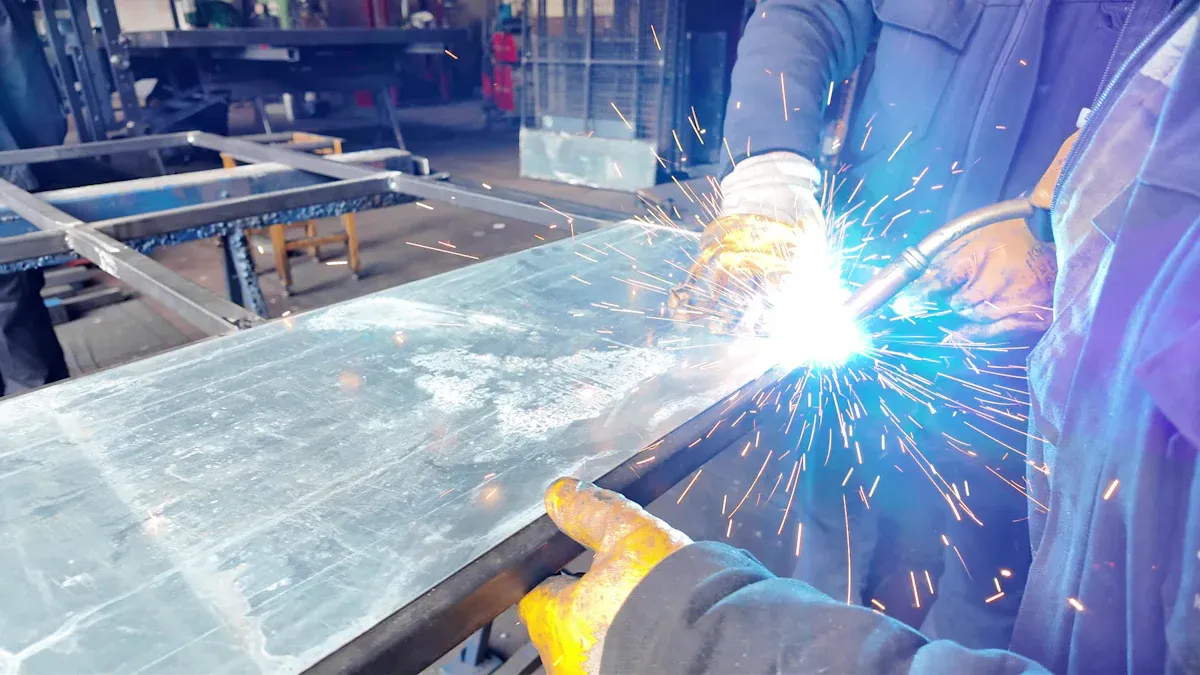What to Know About Friction Stir Welding Machines and Their Uses

Friction stir welding machines are tools for joining materials. They use heat and pressure to soften materials without melting them. This lets the materials join smoothly and strongly. Unlike regular welding, this method avoids holes and cracks. It makes the welds stronger and more reliable.
These machines are very important in manufacturing today. They are used in industries like aerospace, cars, and energy. These areas need strong and perfect joints. New uses include making robots and medical devices, showing their flexibility. Better tools now work with tough metals like titanium. This makes friction stir welding even more useful in factories.
Understanding Friction Stir Welding Machines
How Friction Stir Welding Machines Work
Friction stir welding (FSW) machines use a special joining method. They don’t melt materials but soften them with heat and pressure. A spinning tool with a pin and shoulder creates heat by friction. The pin goes into the material, and the shoulder presses down to join it.
Most heat comes from the tool's shoulder because it is bigger. This heat softens the material so the pin can mix it well. Scientists use math to predict heat from friction during the process.
FSW avoids problems like holes and cracks, making strong joints. It is popular in industries needing precise and durable connections, like aerospace and car making.
Key Components of Friction Stir Welding Machines
FSW machines work well because of their important parts. Each part has a specific job:
Component | Job |
|---|---|
The shoulder | Makes heat by friction and holds softened material in place. |
The tip (or pin) | Goes into the material to mix it and improve the weld. |
The tool body | Links the tool to the machine and handles heavy stress during use. |
These parts work together to control the welding process. Things like tool speed, angle, and depth affect how good the weld is.
Differences Between Friction Stir Welding and Traditional Welding
Friction stir welding is different from regular welding in many ways:
Process Mechanics: FSW softens materials, while regular welding melts them.
Advantages of FSW: It is stronger, cheaper, and better for the environment.
Limitations of FSW: The machines cost more and need skilled workers.
Applications: FSW is great for aerospace, cars, and ships where strong joints are needed.
Since FSW doesn’t melt materials, it reduces stress and bending. This makes it perfect for jobs needing high accuracy.
Advantages and Limitations of Friction Stir Welding
Advantages of Friction Stir Welding
Strong welds with fewer problems
Friction stir welding makes strong welds without cracks or holes. It doesn’t melt materials, so it avoids cooling problems. This method creates welds that are strong and last longer. It’s great for jobs needing strong joints, like in planes and cars.
Saves energy and helps the environment
FSW uses less energy and is better for the planet. It doesn’t need extra materials or gases, so there’s less waste. The process uses less heat, which keeps parts from bending. This makes it perfect for making lots of items quickly and neatly.
Joins different materials together
FSW can join materials that are hard to weld, like aluminum and steel. This makes it useful for many industries. It helps create new designs and lighter products. For example, it’s used in shipbuilding to join big panels made of different materials.
Limitations of Friction Stir Welding
Expensive machines to start
FSW machines cost a lot at first. Smaller companies might not afford them. But for making many items, the benefits like fewer defects and less waste make it worth the cost.
Works with certain materials and thicknesses
FSW works best with materials that can handle heat, like aluminum. It doesn’t work well with very thick or hard materials. You need to check if your materials are right for FSW before using it.
Needs skilled workers
FSW machines need trained workers to use them. Operators must control speed, angle, and depth carefully. Training takes time and money, but skilled workers can make high-quality welds. This makes the training worth it for industries needing strong joints.
Materials and Joint Designs in Friction Stir Welding
Materials Used in Friction Stir Welding
Friction stir welding (FSW) is a flexible joining method. It works with many materials without melting them. Aluminum and its alloys are the most common, but it also joins metals like copper, magnesium, and steel.
Aluminum and its Alloys
Aluminum is lightweight and resists rust, making it very useful. It is popular in industries like aerospace, cars, and ships. Different types of aluminum have special uses:
Material Series | Features | Uses |
|---|---|---|
AA2000 | Strong, used in manufacturing | Trains, Ships, Planes, Cars |
AA5000 | Light and resists rust | Transport industries |
AA6000 | Strong and lasts long | Saves fuel, Reduces pollution |
AA7000 | Great for solid-state welding | Many industrial uses |
Aluminum alloys are often mixed to make strong, light, and rust-free structures.
Copper, Magnesium, and Other Non-Ferrous Metals
FSW can also join metals like copper, magnesium, and brass. These metals are hard to weld using regular methods. FSW avoids cracks and makes strong, smooth joints.
Steel, Titanium, and Mixed Material Combinations
FSW works with tough metals like steel and titanium too. These need more heat and pressure, but modern machines handle them well. It can even join different metals, like aluminum and steel, for advanced designs like robots.
Joint Designs for Friction Stir Welding
The way you design a joint affects how strong the weld is. FSW supports different joint types for various needs.
Butt Joints
Butt joints are simple and common. Two plates are placed edge-to-edge and held down. This setup creates strong welds and is widely used.
Lap Joints
Lap joints overlap two plates. The tool goes through the top plate into the bottom one. This type is great for joining materials with different thicknesses.
T-Joints and Other Configurations
T-joints and fillet joints mix features of butt and lap joints. These designs are made for specific engineering needs and work well for complex projects.
"FSW joint designs, like butt and lap joints, help keep parts aligned and precise, making them perfect for high-quality jobs."
Picking the right material and joint design helps make strong and lasting welds.
Applications of Friction Stir Welding in Industries
Aerospace Applications of Friction Stir Welding
Strong and lightweight parts
Friction stir welding is very useful in aerospace work. It helps make strong and light parts for planes and spacecraft. The welds are high-quality and handle tough conditions. For example:
NASA uses it in rockets for strength and accuracy.
Boeing uses it in Delta II and Delta IV rocket fuel tanks.
Plane makers use it for fuselages, wings, and fuel tanks.
Application | Benefits |
|---|---|
Aircraft Components | Used for making fuselages, wings, and fuel tanks. |
Rockets | NASA uses it for strong and precise rocket parts. |
Fuel Tanks | Boeing uses it for stronger welds in rocket fuel tanks. |
This method keeps parts light but strong, which is key in aerospace.
Automotive Applications of Friction Stir Welding
Better fuel-saving car parts
In cars, friction stir welding joins light materials easily. This lowers car weight, saving fuel and boosting performance. Companies like Tesla and Ford use it in electric cars to make them stronger and reduce flaws.
Aspect | Impact |
|---|---|
Fuel Efficiency | Joins light materials, cutting weight and saving energy. |
Structural Integrity | Makes strong joints, improving car part durability. |
Industry Adoption | Tesla and Ford use it for better electric car designs. |
By joining different materials, this method helps create new car designs and eco-friendly production.
Shipbuilding and Marine Applications
Connecting big panels and parts
Friction stir welding is common in shipbuilding for joining big panels. It makes strong welds with little bending, perfect for ships. Examples include:
Aluminum panels for the Super Liner Ogasawara ship.
Fish freezer panels first made by Sapa in 1996.
Decks and helicopter platforms by Marine Aluminium Aanensen.
Application | Description |
|---|---|
Super Liner Ogasawara | Aluminum panels made by Mitsui Engineering and Shipbuilding. |
Fish freezer panels | First used by Sapa in 1996. |
Deck panels and helicopter platforms | Made by Marine Aluminium Aanensen. |
This process makes stiff panels that last long and resist tough sea conditions.
Other FSW Applications
Railway, electronics, and renewable energy sectors
Friction stir welding is now used in new industries. It helps make strong, exact, and long-lasting joints.
In railways, it builds train carriages with strong and accurate joints. This is important for fast trains. It also makes train parts lighter, saving energy and improving speed.
In electronics, it helps make electric car batteries. It joins different materials, fixing issues like heat expansion. This makes batteries safer and work better. It is also used in other electronic parts needing strength and precision.
Renewable energy also uses friction stir welding. It builds wind turbines with strong, sealed joints. This helps turbines handle bad weather. It is also used for subsea pipelines and heat exchangers, which are key for energy systems.
Here are examples of FSW in these industries:
Railway: Making train carriages for fast trains.
Electronics: Joining parts in electric car batteries.
Renewable Energy: Building wind turbines, pipelines, and heat exchangers.
Friction stir welding improves safety, performance, and efficiency. Its flexibility makes it useful for modern factories.
Friction stir welding machines changed manufacturing by making strong joints. This method avoids common welding problems and looks neat. It works with many materials and joint types. It can weld tricky shapes without extra metals or gases.
Industries like planes, cars, and ships use FSW for better results. It helps make light car parts and tough ship panels. These uses show how flexible and useful it is. If you need accurate, strong, and eco-friendly welding, FSW is a great choice.
FAQ
What makes friction stir welding better than traditional welding?
Friction stir welding makes stronger joints without melting materials. This avoids problems like cracks and holes. It also saves energy, making it eco-friendly and efficient.
Can friction stir welding connect different materials?
Yes, it can join materials like aluminum and steel. This is great for industries needing strong and light designs, like cars and planes.
Is friction stir welding good for thick materials?
Friction stir welding works best on thin to medium materials. For very thick ones, special tools or changes might be needed.
Do you need training to use friction stir welding machines?
Yes, training is needed to operate these machines. Workers must learn to control speed, angle, and depth. Skilled operators make sure the welds are high-quality.
Which industries use friction stir welding the most?
Industries like aerospace, cars, ships, and renewable energy use it a lot. It’s also growing in electronics and train manufacturing for strong and precise parts.
Tip: Before using friction stir welding, check your material type, thickness, and project needs to see if it’s the right choice.
See Also
A Guide to Various Powder Coating Techniques and Applications
Understanding Functional Testing in CNC and Die Casting
An Overview of Sandblasting Techniques and Their Uses
A Comprehensive Look at Various CNC Cutting Tools
Top 10 Important Metal Surface Finishing Techniques to Learn
About Hunan Puka
Established in 2016 and based in Hunan, China, with a liaison point in Berlin, we are a Tier 2 supplier for the automobile industry. We specialize in the production of customized aluminum die-casting parts designed for machines with a closing force ranging from 280 to 1250 tons, with subsequent manufacturing process CNC machining and surface treatment. Our commitment to quality is reflected in our accredited quality management system, certified by ISO9001:2015 and IATF16949:2016 standards.


